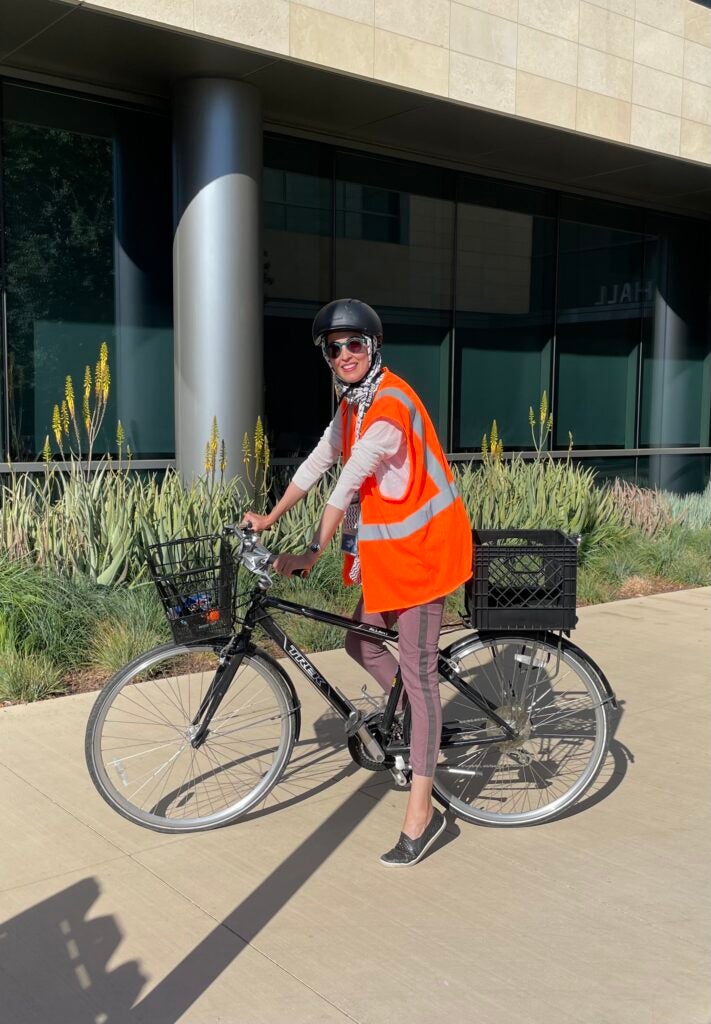SRWC employee finds pandemic’s silver lining, masters the two-wheel commute
While some folks learned how to speak a new language or bake bread during quarantine, Aisha Wahab re-learned how to ride a bike.
Aisha Wahab dreamed of a commute where she could take public transportation, walk or ride to work. When she was hired to work at Stanford Redwood City in 2019, she specifically hunted for apartments in Redwood City. She didn’t own a bike, so she walked halfway, then took the shuttle from the Redwood City train station. She never stopped thinking about biking, though, and how the mode would add flexibility to her schedule, not to mention a twice-a-day cardio workout.

After 20 years, Aisha Wahab re-learned to ride a bike and now commutes on two wheels to SRWC
As a paper conservator for Stanford Libraries, Aisha’s hands-on work preserving and repairing paper items – including maps, documents, works of art on paper and posters – dictated she return to work in a hybrid capacity.
In July 2020, four months after the Bay Area began sheltering in place, she returned to her commute– three days on campus and two days working remotely. She did this for two weeks with one half of her unit while the other half worked remotely. The groups then switched for the next two weeks and so on.
With city streets now vacant, Aisha began to rethink her biking dream, turning to the Stanford Transportation website for inspiration.
“The online bike webinars were a silver lining during the last year, especially since I’m a novice,” said Aisha. She rode as a child and again in college, but it had been 20 years since she had ridden. She was raring to feel the wind at her back and ding her bike bell again.
When it came time to purchase a bike, Aisha learned about the Stanford Department of Public Safety (DPS) Bicycle Sale. “Luckily, I remembered from one of the biking webinars tips on how to choose a bike, taking into account the type, mountain or road bike versus folding bike, and the importance of finding the ideal size.”
After scheduling an appointment to check out abandoned bikes at the DPS bike compound, she found her dream bike with a bell and rack for just $30 at that time. “It’s fantastic and the price was right,” she said. “They even registered the bike for free with Project 529 and sent me to the Campus Bike Shop to get a full tune up. It was one-stop shopping.”
One pair of new brake pads later, she watched Stanford Transportation’s “How to Map a Bike Route” webinar to determine the best route. Her three-mile daily route is slightly longer than the straight shot, but worth it for safety-conscious Aisha.
Hard to miss in her orange DayGlo reflective vest, Aisha is still searching for the perfect helmet.
“For people who cover their hair like I do, finding one that works for your hijab, tichel, dastar, etc., can be a bit of a challenge. I tried on many and eventually found one that worked, even if it looks ginormous on my head. I usually have to readjust my hijab when I get to work, but I care about my head so safety first,” she said with a laugh. Aisha hopes bike companies will offer headwrap-friendly helmets in the future.
Nowadays, cycling is Aisha’s go-to mode of transportation. Along with her department colleagues, she commutes to campus at least two days a week. Her favorite part is getting her mind and body moving so she arrives at work feeling energized each day.
Aisha’s advice for others is the same she might have given herself a year ago: Do a little research, ride on a route and at a time that works for your comfort level, and just give it a try.
Visit Stanford Transportation’s bike program page for more details and program updates. For information about abandoned-bike sales, visit the Stanford Department of Public Safety (DPS) Bicycle Sale website.
If you have questions or need help with your transit commute, we’re here to help. Contact us at commuteclub@stanford.edu or request a one-on-one commute consultation.